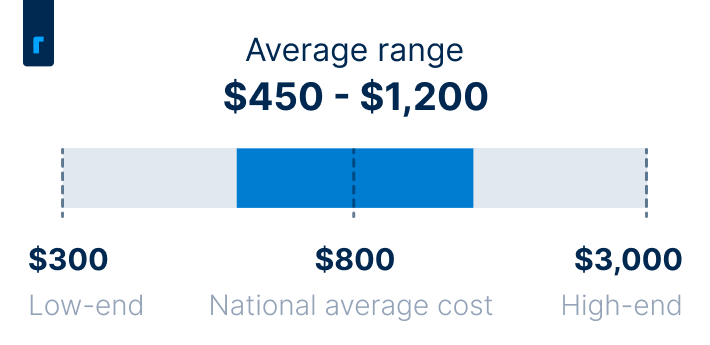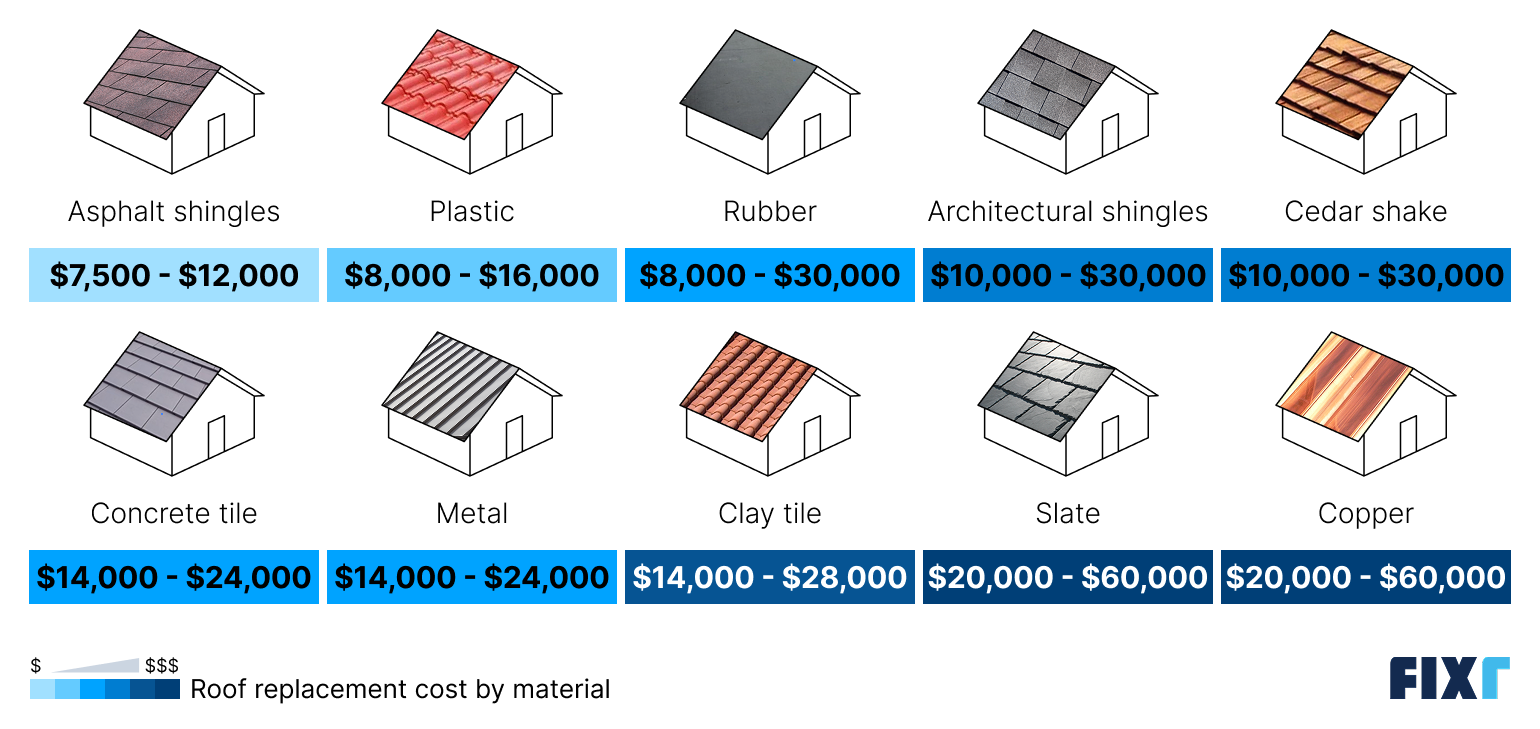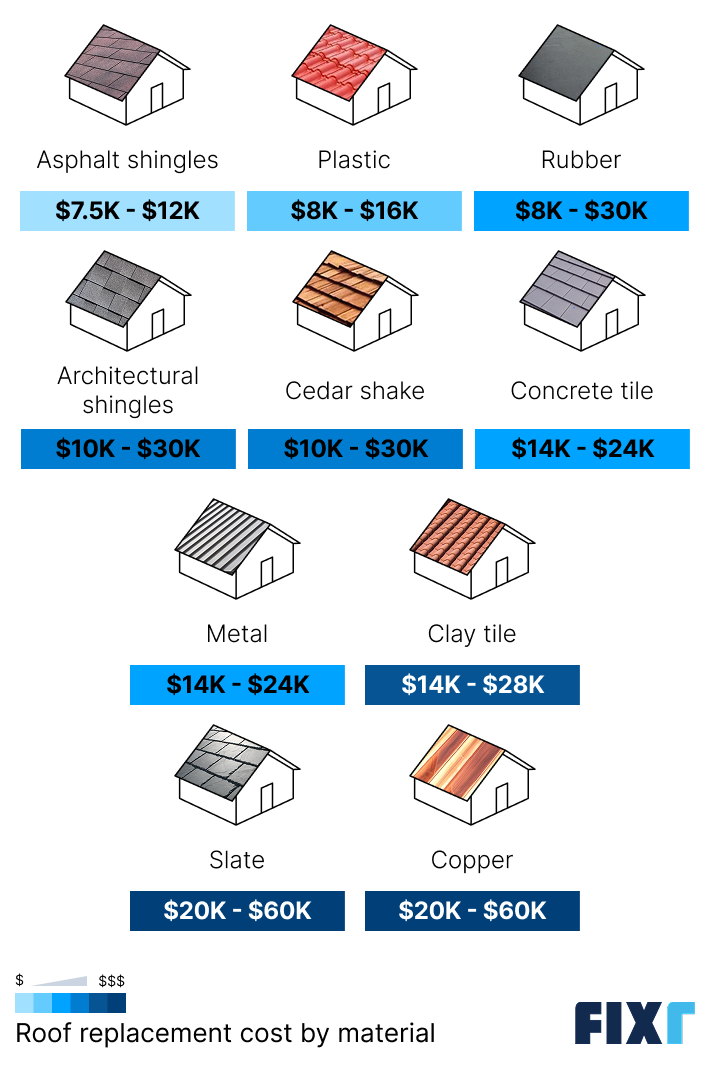Updated: August 20, 2025
Written by Dan Simms
Nieves is a home remodeling editor at Fixr.com with special interest in landscaping, pest control, painting, installation, and repair projects. She brings her work ethic, creativity, and love for teamwork into everything she does, including working with writers and designers at Fixr.com to develop useful and comprehensive guides for homeowners.
Learn moreReviewed by Nieves Martinez
Your roof is not only a crucial part of your home’s structural components, but it also serves to keep you and your family safe from the elements. Replacing your roof is a big investment, and doing it before you start experiencing problems like leaks and water damage might seem like an unnecessary spend, but staying ahead of roof issues is one of the best ways to avoid major property damage and even efficiency losses and high utility bills.
Roof replacement costs an average of $10,000, and prices typically fall between $7,500 and $14,000, depending on your home size, the roofing material you want, the roof style, and the cost of labor in your area.
Average Roof Replacement Cost


Average Cost of Roof Replacement by Roof Size
Roofing contractors usually price out your house roof replacement costs by the square foot or by the roofing square, which is 100 square feet. On average, the cost per square foot for roof replacement is $4.75 for materials and labor, but prices typically range from $3.75 to $11 per square foot, depending on material options.
You can estimate your total cost for roof replacement by calculating your roof’s square footage and then multiplying by the average cost per square foot. It’s important to note that your roofer will use your roof’s square footage and not the square footage of your living space. The two measurements are related but don’t always scale perfectly, so you’ll need to measure your roof for an accurate estimate.
Here’s what you can expect to pay based on the size of your roof:
Home Size (sq. ft.) | Average Roof Square Footage | Typical Cost Range |
1,000 | 1,200 | $4,500 - $13,200 |
1,500 | 1,800 | $6,750 - $19,800 |
1,700 | 2,000 | $7,500 - $22,000 |
2,000 | 2,400 | $9,000 - $26,400 |
2,500 | 3,000 | $11,250 - $33,000 |
3,000 | 3,600 | $13,500 - $39,600 |
Cost of Roof Replacement by Material
The overall cost for roof replacement varies so widely, mostly because of the material options available. Asphalt shingles are the most common type of roofing material in the U.S., as they balance affordability, availability, durability, value, and ease of installation and repair. A new asphalt shingle roof costs an average of $10,000.
You have many other materials to choose from, though, which can affect your upfront cost, roof longevity, durability in extreme weather, curb appeal, and even your home’s energy efficiency. Metal roofing, cedar shakes, and clay or concrete tiles are the most common alternatives to asphalt shingle roofs, as they all also offer good value.
While the upfront investment is a major consideration when choosing your roofing material, there are other factors that can’t be overlooked, like how well it stands up to your local climate, what kind of insulation it provides, and how long it will last.


Material | Cost |
$7,500 - $12,000 | |
$8,000 - $16,000 | |
Rubber | $8,000 - $30,000 |
$10,000 - $30,000 | |
$10,000 - $30,000 | |
Concrete tile | $14,000 - $24,000 |
$14,000 - $24,000 | |
$14,000 - $28,000 | |
$20,000 - $60,000 | |
$20,000 - $60,000 |
All of the prices in the table above are calculated based on a home square footage of 1,700 sq. ft., and using an average roof square footage of 2,000 sq. ft.
Labor Cost for Roof Replacement
Labor accounts for between 40% and 60% of your total roof replacement cost or an average of between $4,000 and $6,000. This includes the cost to remove your old roof and haul away the debris, install new underlayment, and lay the new roofing material.
Labor costs vary based on several key factors:
How heavy and challenging it is to remove your old roof. You’ll pay more to remove heavy concrete tile or slate than you would asphalt shingles.
How easy the installation process for your new roofing material is. You’ll pay more for something like concrete, clay, or slate, which takes longer to install than simply nailing down asphalt shingles.
How complex your roof is. You’ll pay the least for a simple gable roof with a single ridge and no hips or valleys that need additional flashing and shingle breaks.
The hourly rate for roofers in your area, which varies based on demand, local cost of living, and whether you’re in an urban, suburban, or rural area.
Cost for Roof Replacement by Location
Roof replacement costs vary based on location for a few reasons. First, the popularity of different roofing materials varies by climate. For example, more expensive and insulating clay tile roofs are prevalent in the hot south, as they boost home energy efficiency. Metal roofs that shed snow well are more popular in the northern states that see heavy snowfall. Climate affects what roofing materials are appropriate, but you may also need to consider installing other features like roof vents in hotter climates and ice shields in colder climates, which can add to your total.
Additionally, the cost of living drives labor costs, so your prices will tend to be higher in major metropolitan areas than in rural areas. You’ll pay more in an area like San Francisco or New York City than you would in rural areas in California and New York, as labor costs outside of those major cities are much lower.
Live in a hot climate and want to make sure your new roof can stand up to the heat? Check out our article on the best roof materials for hot climates to see which roofing materials will insulate your home, keep you cool, and reduce utility costs during the hottest summers.
Additional Cost Factors
There are many other factors that can influence your roof replacement costs, so be sure to consider all of the following if you want the most accurate estimate possible.
Roof Pitch and Shape
Roof pitch or slope affects your roof replacement costs in two ways. First, steeper roofs increase your roof’s square footage, even as interior square footage remains the same, so a higher slope will result in more square footage you have to pay to cover. Second, very steep roofs, like those found in snowy states, require additional safety equipment to make the work safer. Harnesses and scaffolding make the job take longer, which drives up labor costs.
The shape and design of your roof also matter. Simple gable roofs are the easiest and fastest to re-roof because your roofer only needs to deal with a single ridge and two roof planes. A hip roof, for example, has four hips and four planes, which complicates the installation, increasing labor costs. Other roof designs can drive up labor prices even more, as every hip, valley, and ridge takes longer to install flashing and create seams between the planes.
Roof Removal and Disposal Costs
The average cost to tear off and replace a roof is $50 per square (100 square feet), which includes dumping and disposal fees. Your price could climb up to $150 per square if you’re removing heavier materials, like concrete tiles, or if you have multiple layers of asphalt shingle that you’re removing. The total will also depend on local dumping and recycling costs.
Underlayment and Weatherproofing
Roofing contractors will include the cost of underlayment in their per-square-foot prices, but you may need to budget for upgrades or additional weatherproofing, depending on your climate. In colder climates, you may need to pay for an ice and water shield. Standard roofing felt costs between $0.05 and $0.10 per square foot for materials, while ice and water shield costs around $0.50 per square foot, so this upgrade would add around $50 per square to your total.
In hotter climates, your price could increase by $100 to $1,000 if you need to install or repair roof vents to prevent your roofing from overheating or by $1,000 to $2,000 if you need to add insulation under your roofing to help boost home efficiency in particularly hot weather.
Structural Repairs
When your roofing professional removes your old roof, there’s a chance they’ll find hidden damage, usually from ongoing roof leaks. Roof decking costs between $2 and $8 per square foot to replace, and fascia and soffit repairs can add between $500 and $2,500 to your total, depending on the extent of the damage. Major structural repairs to damaged rafters can add up to $5,000 to your total.
Permits and Code Requirements
Roof replacement permits are required in most cities and will add between $100 and $500 to your roof replacement costs, depending on your local building department’s permit fee schedule. Some areas charge flat fees, while others charge based on the project cost, and some cities don’t require permits at all if you’re sticking with the same roof material, so permit costs vary widely. Ask your roofer or your local building department about fees in your area.
Building code requirements can also affect your pricing. For example, homes in many parts of California, Texas, North Carolina, and Florida must have fire-resistant roofing due to the risk of wildfires. Fire-resistant roof materials or protective coatings can add thousands to your total. Some states also have code requirements that demand impact-resistant or wind-resistant shingles to stand up to hurricanes, tropical storms, and tornadoes, and these materials also add to your total.
Warranty
Most roofing contractors will include a labor warranty that guarantees that poor workmanship won’t lead to a roof issue. Your pro will also pass on the roofing manufacturer’s warranty, which covers defects in the product itself. Roof warranties vary widely based on the manufacturer and the installer you hire. This isn’t a separate line item on your estimate, but you’ll usually pay higher labor costs for reputable companies that deliver above-average warranty coverage and use high-quality materials.
If you have solar panels installed on your roof, you’ll need to pay a solar installer to remove them and then reinstall them after you replace your roof. This can cost anywhere from $500 to $2,000, depending on how long you need to store the panels and where you choose to store them.
Roof Repair vs. Replacement
Roof repairs cost an average of just $900, which is less than a tenth of what a replacement costs. Deciding whether you can get away with a roof repair or need a complete replacement is paramount to maximizing your long-term value.
Unfortunately, repairs aren’t always the best option; they are usually a good option if you know your roof has a decade or more of useful life left and is suffering from localized damage, whether it’s from a fallen tree, blown debris, or a weather-related incident.
More widespread damages demand a full replacement. Check your roof for visible damage. If you see just a few cracked or missing shingles, pockmarks from hail, or impact damage from tree limbs, a repair is probably best. If you notice that many of your shingles are missing shingle grit, have heavy discoloration, or are covered in moss, these are signs you need a roof replacement.
DIY Roof Work vs. Hiring a Pro
Working on a roof yourself is dangerous, and it’s easy to mess up the old roof removal and the new roof installation. It’s also easy to make mistakes as a DIYer, and these can end up costing you more than you’d save on labor if they lead to the need for roof repair and water damage repair.
Even if you’re comfortable with the roofing work itself, you won’t be able to assess hidden damages as well as a professional would, and ignoring necessary structural repairs to decking and rafters could lead to ongoing roof problems that also cost you more over time.
Finally, and perhaps most importantly, roofing manufacturers will almost always void your roof’s warranty if you don’t have the materials installed by a pro, so you’ll miss out on 30 years of roofing material protection, on average, and you also won’t get any workmanship warranty to ensure a problem-free roof going forward. Overall, the peace of mind you get from hiring a pro is well worth the cost of the labor.
How to Choose a Roofing Contractor
Choosing the right roofing contractor can mean the difference between a roof that lasts you decades without issues and one that looks unprofessional and leads to leaks and other problems within just a few years. Here are a few tips for finding a reputable contractor that gets the job done correctly the first time around.
Confirm your roofer is licensed and insured: You can ask your contractor for license and insurance information. Double-check using a license look-up tool in your state, and verify that your roofer holds both general liability insurance coverage and worker’s comp insurance.
Ask your roofer for references: Ask each roofer you interview for a list of references. Call those references and ask what past customers liked and didn’t like about the process.
Get multiple quotes: Coordinating with roofers and getting estimates can be time-consuming, but be sure to get at least three quotes. Doing so can help you avoid low-ball estimates with questionable quality, as well as high estimates from roofers who overcharge.
Ask about a warranty: Always ask a roofer you’re considering if your roof comes with a manufacturer’s warranty and a workmanship warranty. Steer clear of roofers who don’t offer both.
Ways to Save on Roof Replacement
The cost of a new roof can cause sticker shock for some homeowners, and in many cases, paying the price for a new roof is just not possible. Roof replacement isn’t something you want to put off, though, so instead of delaying and potentially opening your home up to ongoing damages, use the following tips to bring down costs.
Choose a roof overlay, if possible: In some areas, you can install up to three layers of asphalt shingles before a total rip-and-replace is necessary, and in others, you can install certain roofing materials over others. Overlays will save an average of $1,000.
Consider financing options: There are many ways to finance a re-roofing project, including renovation loans, home equity lines of credit, credit cards, and cash-out refinances.
Take advantage of rebates and tax credits: In some areas, usually in more extreme climates, you may have access to energy efficiency rebates and tax incentives for specific roofing materials that improve your home’s efficiency.
Lean on homeowner’s insurance: If your old roof was damaged by extreme weather, contact your homeowner’s insurance company to see if repairs or a replacement would be covered.
Schedule during the off-season: Demand for roofing services is highest in the spring, so you could see small breaks on pricing if you schedule in the fall.
FAQs
Paying $30,000 for a new roof could make sense, depending on the size of your home and the roofing material you’re installing. The average cost to install a new asphalt shingle roof on a 1,700-square-foot home that requires an average 2,000 square feet of roofing is $10,000, but oversized homes and high-end materials like metal, clay, concrete, or slate could easily bring the total up to $30,000 or more.
The average lifespan of a new roof varies based on the materials, but a standard asphalt shingle roof should last for 20 to 30 years. Metal roofs can last for 50 to 70 years, clay and concrete roofs last up to 100 years, and slate can last up to 150 years. Your climate plays a role in your roof’s lifespan, as does the ongoing maintenance you carry out.
Yes, you can finance a roof replacement, and there are many options available to you. Credit cards and home equity lines of credit provide variable financing amounts that are ideal if you don’t know what your roof replacement will cost. If you have a firm estimate, a renovation loan or home equity loan could help cover the upfront costs and let you pay over time.
Roof replacement is very noisy, and it will disrupt you and your family for between one and seven days, depending on the type of material you’re installing and the size and complexity of your roof. Working from home isn’t advisable during roof replacement, and even conversations indoors can be challenging with the noise. It’s best to relocate during roof replacement, especially if you have children or pets or if the job will take several days.
The cost of roof replacement per square foot averages $4.75, but you could pay anywhere from $3.75 to $11 per square foot on average, depending on the material you choose.
Installing a new roof will improve your home’s curb appeal and give buyers more confidence in your home, which will add to the value. Roof replacement comes with an average return on investment of between 60% and 70%, which means adding between $6,000 and $7,000 to your home value, based on the average roof replacement cost.
